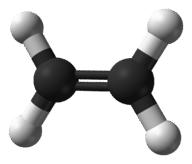10.12 确定经验公式
Section outline
-
What is occurring in this picture?
::这张照片中发生了什么?In the early days of chemistry , there were few tools for the detailed study of compounds. Much of the information regarding the composition of compounds came from the elemental analysis of inorganic materials. The “new” field of organic chemistry (the study of carbon compounds) faced the challenge of not being able to characterize a completely. The relative amounts of could be determined, but so many of these materials had carbon, hydrogen, oxygen, and possibly nitrogen in simple ratios. We did not know exactly how many of these atoms were actually in a specific molecule.
::在化学早期,对化合物进行详细研究的工具很少,关于化合物构成的信息大多来自对无机材料的元素分析。有机化学的“新”领域(碳化合物研究)面临无法完全定性的挑战。相对数量可以确定,但这些材料中有很多是碳、氢、氧,也可能是氮的简单比例。我们不知道这些原子中有多少实际存在于特定分子中。Determining Empirical Formulas
::确定经验公式An is one that shows the lowest whole-number ratio of the elements in a compound. Because the structure of is an extended three-dimensional network of positive and negative , all formulas of ionic compounds are empirical. However, we can also consider the empirical formula of a molecular compound. Ethene is a small compound with the formula C 2 H 4 (see Figure ). While C 2 H 4 is its and represents its true molecular structure, it has an empirical formula of CH 2 . The simplest ratio of carbon to hydrogen in ethene is 1:2. There are two ways to view that ratio. Considering one molecule of ethene, the ratio is 1 carbon for every 2 atoms of hydrogen. Considering one mole of ethene, the ratio is 1 mole of carbon for every 2 moles of hydrogen. So the subscripts in a formula represent the of the elements in that formula.
::是一个显示化合物中元素最小整数比例的化合物。 由于其结构是一个由正和负组成的三维扩展网络, 离子化合物的所有公式都是实验性的。 但是, 我们还可以考虑分子化合物的经验公式。 乙烷是配有公式C2H4(见图)的小型化合物。 虽然C2H4是它的, 代表其真正的分子结构, 它有一个CH2的经验公式。 乙烯中碳与氢之间的最简单比例是 1: 2 。 有两种方法来观察这个比例。 考虑到一个乙烯分子, 每2个氢原子的比是1 碳。 考虑到一个乙烯分子, 每2个氢原子的比是1 。 考虑到一个乙烯分子, 每2个氢分子的比是1 个碳。 每2个氢分子的比是1 。 因此, 公式中的子标注代表该公式中元素的值。Ball-and-stick model of ethene, C 2 H 4 .
::C2H4 苯乙烯球棒模型In a procedure called elemental analysis , an unknown compound can be analyzed in the laboratory in order to determine the percentages of each element contained within it. These percentages can be transformed into the mole ratio of the elements, which leads to the empirical formula. The steps to be taken are outlined below.
::在称为元素分析的程序中,可以在实验室内分析未知化合物,以确定其中每个元素的百分比,这些百分比可转化为元素的摩尔比,从而得出经验公式。 拟采取的步骤概述如下。-
Assume a 100 g sample of the compound so that the given percentages can be directly converted into grams.
::假定对化合物进行100克的抽样调查,使规定的百分比能够直接转换成克。 -
Use each element’s
to convert the grams of each element to moles.
::使用每个元素将每个元素的克转换为摩尔。 -
In order to find a whole-number ratio, divide the moles of each element by whichever of the moles from step 2 is the smallest.
::为了找到一个整数比率,每种元素的摩尔数除以摩尔与第二步中最小的摩尔中的哪一个。 -
If all the moles at this point are whole numbers (or very close), the empirical formula can be written with the moles as the subscript of each element.
::如果目前所有的内鬼都是整数(或非常接近),经验公式可以用内鬼作为每个元素的下标来写。 -
In some cases, one or more of the moles calculated in step 3 will not be whole numbers. Multiply each of the moles by the smallest whole number that will convert each into a whole number. Write the empirical formula.
::在某些情况下, 第3步计算出的一个或多个摩尔将不是整数。 将每个摩尔乘以最小整数, 将每个摩尔转换成整数。 写入实验公式 。
Sample Problem One: Determining the Empirical Formula of a Compound
::样本问题一:确定一个化合物的经验公式A compound of iron and oxygen is analyzed and found to contain 69.94% iron and 30.06% oxygen. Find the empirical formula of the compound.
::对铁和氧化合物进行分析,发现其中含有69.94%的铁和30.06%的氧。找到化合物的经验公式。Step 1: List the known quantities and plan the problem.
::第1步:列出已知数量并规划问题。Known
::已知已知-
% of Fe = 69.94%
::占费的%=69.94% -
% of O = 30.06%
::占O的百分比=30.06%
Unknown
::未知-
Empirical formula = Fe
?
O
?
::经验公式 = Fe? O?
Steps to follow are outlined in the text.
::案文概述了应采取的步骤。Step 2: Calculate.
::第2步:计算。1. Assume a 100 g sample.
::1. 假定100克样本。
::69.94 g Fe30.06 g O2. Convert to moles.
::2. 转换为内鬼。
::69.94 g Fex1 mol Fe55.85 g Fe=1.252 mol Fe30.06 g Ox1 mol O16.00 g O=1.879 mol O3. Divide both moles by the smallest of the results.
::3. 将两种摩尔除以最小的结果。
::1.252 mol Fe1.252=1 mol Fe1.879 mol O1.252=1.501 mol O4/5. Since the moles of O, is still not a whole number, both moles can be multiplied by 2, while to a whole number.
::4/5. 由于O的内鬼仍然不是整数,两种内鬼可以乘以2,而乘以整个数字。
::1 摩尔 Fex2=2 摩尔 Fe1.501 摩尔 Ox2=3 摩尔 OThe empirical formula of the compound is Fe 2 O 3 .
::化合物的经验公式是Fe2O3。Step 3: Think about your result.
::步骤3:想想你的结果。The subscripts are whole numbers and represent the mole ratio of the elements in the compound. The compound is the ionic compound iron(III) oxide.
::下标是整数,代表化合物中元素的摩尔比。化合物是离子化合物氧化铁(III)。Summary
::摘要-
A process is described for the calculation of the empirical formula for a compound based on the percent composition of that compound.
::根据化合物的构成百分比计算化合物实证公式的过程。
Review
::回顾-
What is an empirical formula?
::什么是经验公式? -
What does an empirical formula tell you?
::经验公式告诉你什么? -
What does it not tell you?
::它怎么没告诉你?
-
Assume a 100 g sample of the compound so that the given percentages can be directly converted into grams.

